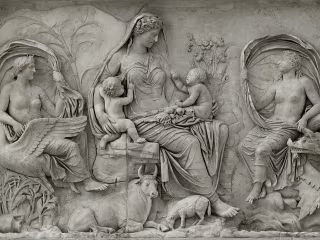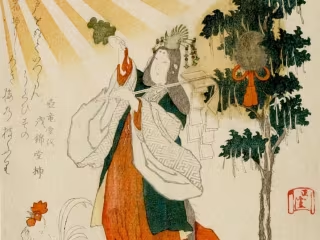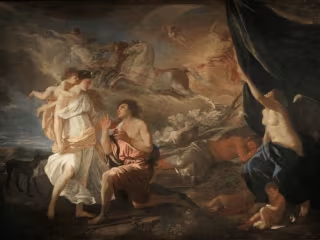Shakti: Goddess of Divine Feminine Power
0
Ghostwriter
Blog Writer

Shakti is a highly esteemed figure within the complex mythology of Hinduism, representing the divine feminine power that drives the universe and embodies both the constructive and destructive aspects of existence. Her significance spans a wide range of cultural, spiritual, and philosophical contexts, making her a revered and awe-inspiring deity among practitioners of Hinduism.
Overview of Shakti
Often depicted as a goddess, Shakti embodies the dynamic and primordial cosmic energy that flows through the universe. In Hindu mythology, Shakti embodies the divine feminine energy, while Lord Shiva represents the divine masculine energy, and their union symbolizes the balance and harmony within creation (Johnson). Shakti is pivotal in the triad of celestial entities, along with Brahma and Vishnu. She transcends singular forms and manifests in various incarnations, each representing specific facets of her infinite power. Durga, Kali, Parvati, and Lakshmi are among the many forms she adopts to fulfill distinct cosmic functions and cater to diverse human needs (“Shakti”). These manifestations signify her responsive engagement with the ever-changing astral dynamics and human experiences.

Source: Vedicfeed
Titles
Queen of Heaven
Mother of the Universe
Adi Shakti
Abilities
Shakti’s abilities encompass a cosmic spectrum as expansive as the universe she permeates (“Shakti”). Known for embodying the divine feminine energy that nurtures creation and sustenance, she represents the essence of motherhood and care (Johnson). However, Shakti also wields the power for transformation and destruction, symbolizing the cyclical nature of existence (“Shakti – New World Encyclopedia”).
The versatility of Shakti’s abilities is magnificently displayed through her diverse incarnations. As Durga, she embodies valor and conquers evil, reflecting the formidable strength required to overcome adversities. Kali personifies fierce destruction, representing the necessity of breaking down the old to make way for the new. Saraswati embodies wisdom, knowledge, and creativity, reflecting her power’s intellectual and artistic facets (“Shakti”).
Characteristics
The visual depiction of the deity Shakti serves as a remarkable testament to her transcendent power: Her physical form effortlessly blends with her spiritual essence, resulting in an emanating aura that speaks volumes about her divine nature. The portrayal of Shakti with multiple arms is a striking symbol of her multifaceted capabilities, signifying her ability to undertake numerous tasks in the cosmic realm (“Shakti – New World Encyclopedia”).
The radiant glow emanating from her countenance is symbolic and signifies her profound illumination that transcends the confines of mortality (Johnson). This luminosity reflects her connection to the divine source of creation and her role as a guiding force for humanity. Shakti’s physical attributes are not separate from her spiritual nature but blend harmoniously to depict her as a manifestation of beauty, strength, and grace personified (“Shakti – New World Encyclopedia”).
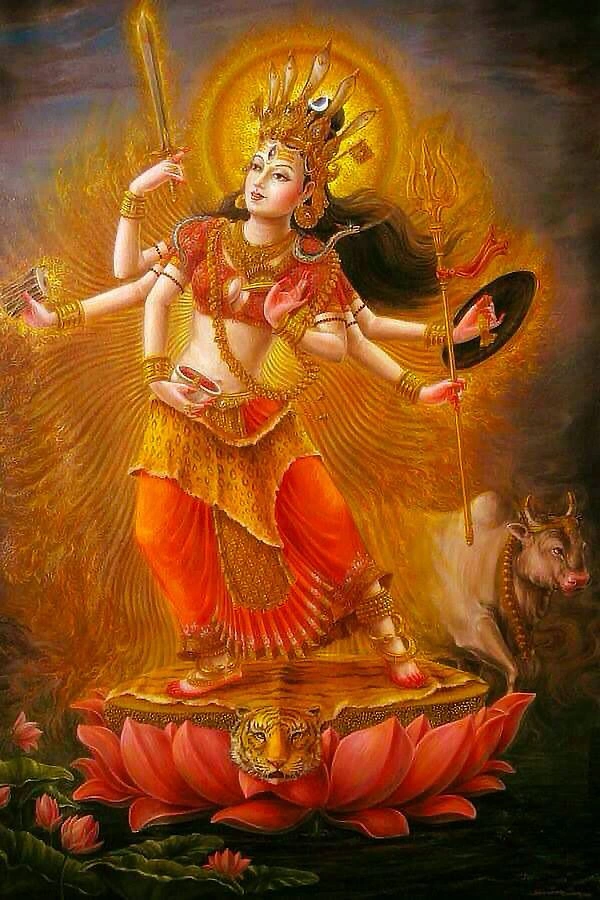
Source: Yogatrotter Academy
Traits
Shakti’s essence of compassion is a testament to her nurturing character. This trait reflects her maternal care for those in need, providing solace for devotees who seek comfort and understanding (“Shakti”). However, it is vital to note that Shakti’s character is not confined to compassionate nature, as she embodies fierce determination and protective strength (Johnson). In the face of adversity, she reveals her formidable side, showcasing the duality of her nature that combines nurturing and assertive qualities (“Shakti – New World Encyclopedia”). This unique blend of traits underlines her crucial role as a harmonizing force within the cosmic balance.
Symbols
The symbols attributed to Shakti serve as a rich tapestry that encapsulates her profound essence. Among them, the lotus takes center stage as a recurring motif, signifying purity and enlightenment – qualities that perfectly align with her divine feminine energy (“Shakti – New World Encyclopedia”). Additionally, her trident, known as the trishula, is a powerful emblem symbolizing her mastery over the three fundamental cosmic functions: creation, preservation, and destruction (“Shakti”). This representation highlights her pivotal role in the cyclical processes of existence, embodying the dynamic interplay of heavenly forces.
Another significant symbol is the tiger, Shakti’s chosen mount, which symbolizes her dominion over nature’s raw and untamed forces (Johnson). This choice resonates with her fierce and protective aspects, underscoring her role as a guardian against evil influences. Ultimately, the symbols associated with Shakti reflect the harmonious blend of her diverse characteristics, seamlessly weaving together her nurturing, authoritative, and untamed aspects.
Festivals and Rituals
The commemoration of Shakti is celebrated through festivities and ceremonies that bear immense cultural and religious significance across the lands of the Indian subcontinent. Navaratri, a nine-night festival, commemorates Shakti’s manifold manifestations; each night is dedicated to a specific form of divine feminine energy (“Shakti – New World Encyclopedia”). This festivity resonates with spiritual depth, embodying the unity of the sacred power that Shakti represents.
The worship of Shakti entails various rituals, such as fasting, meditation, and prayer, which serve as conduits for devotees to connect with their sacred power. The recitation of mantras devoted to Shakti reverberates with spiritual vibrations, invoking her presence and blessings into the lives of her devotees. Tantric practices dive deeper, harnessing the potent energy of Shakti for spiritual growth and inner transformation (“Shakti – New World Encyclopedia”). These practices reflect the devotion, reverence, and aspiration of devotees to align with the cosmic power of Shakti, exemplifying the interplay between the spiritual and earthly realms.
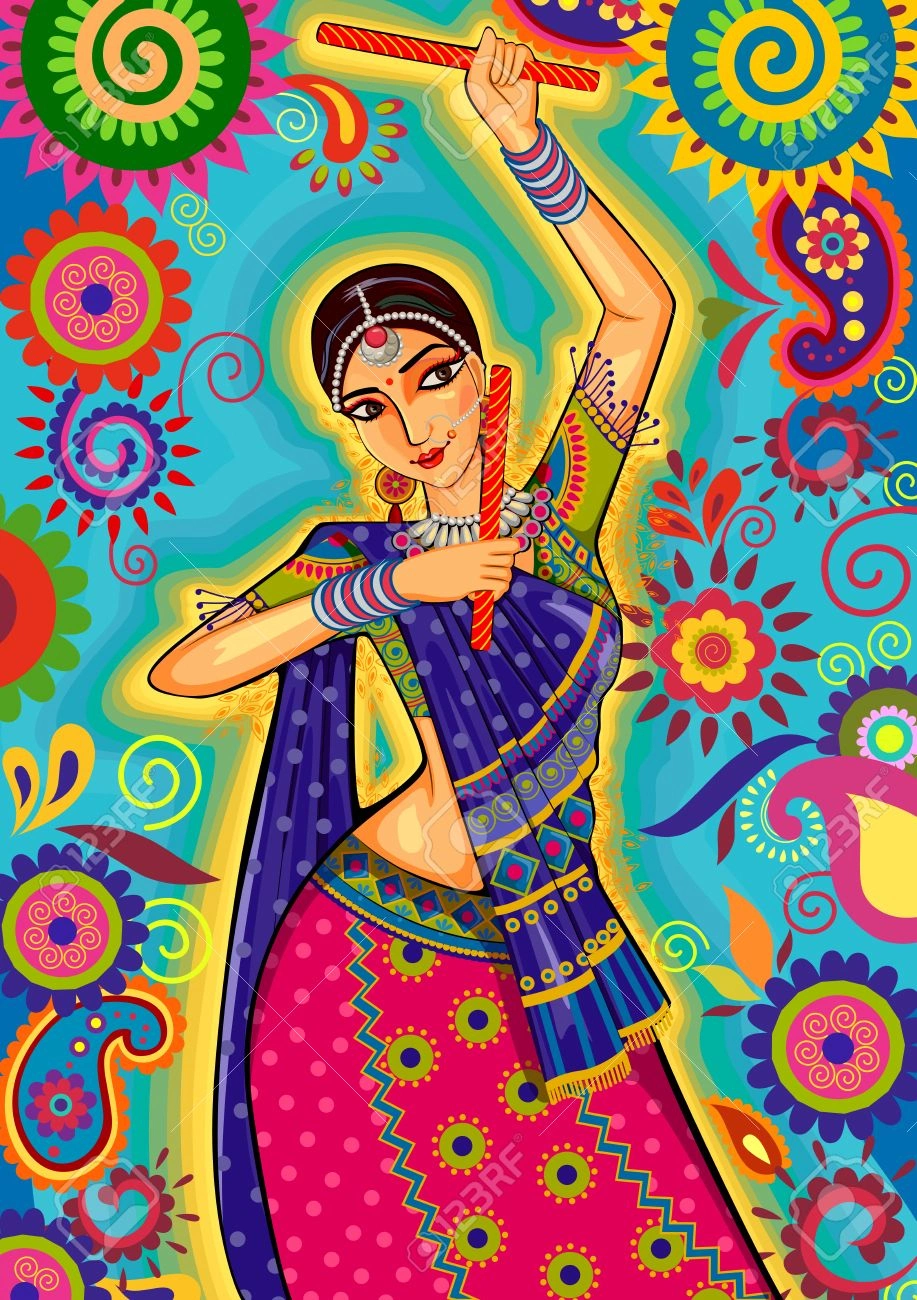
Source: 123RF
Legends associated with Shakti
Shakti assumes a pivotal role, serving as the embodiment of the dynamic and primordial cosmic energy that permeates the universe. Enshrined in the annals of ancient mythology and revered across a multitude of cultures, Shakti encapsulates the profound essence of feminine power and spirituality with a depth and significance that is truly unparalleled.
Origin story
The narrative of Shakti’s origin holds immense significance in Hindu mythology, centering around the myth of the “Shakti Peetha” (“Shakti”). This captivating legend recounts the tragic tale of Sati, the first wife of Lord Shiva, who immolated herself due to her father’s insult. The profound grief that overcame Shiva following this incident led him to retreat from the world, engrossed in deep meditation. This withdrawal caused his cosmic dance, Tandava, to pose a grave threat to the very fabric of the universe.
Lord Vishnu intervened in response to the turmoil, realizing the need to appease Shiva’s grief and restore cosmic balance. Consequently, Vishnu disassembled Sati’s lifeless body, with her body parts descending to separate locations, forming Shakti Peethas as a whole (“Shakti”). These locations subsequently evolved into hallowed sanctuaries, symbolizing the manifestation and influence of Shakti, the divine feminine energy that reverberates across the entirety of creation.
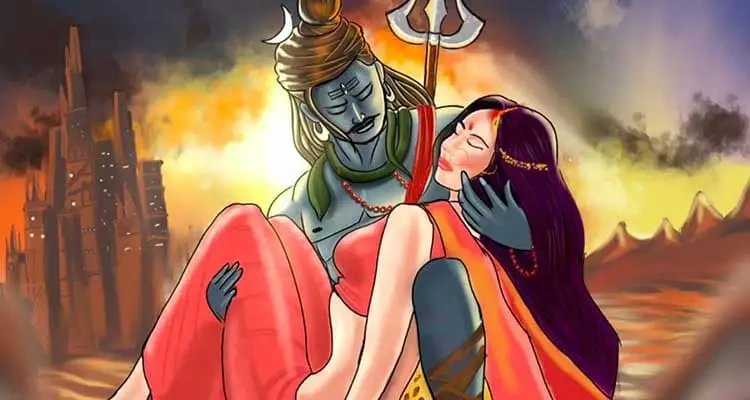
Source: Bonobology
The Triumph of Shakti: The Inspiring Legend of Durga and the Conquest of Evil
The legend surrounding Shakti is both fascinating and inspiring. According to the story, Shakti embodied herself as Durga, a formidable ten-armed goddess crafted to confront and conquer the menacing buffalo demon, Mahishasura. Despite Mahishasura’s invincibility against male deities due to a powerful boon he received, the divine balance found its champion in a female form (Johnson). The gods pooled their divine energies to shape Durga, endowing her with an array of arms and formidable attributes. She engaged Mahishasura in a fierce and relentless battle, symbolizing the struggle between good and evil. Durga’s multidimensional prowess found expression in her ten arms, each wielding a distinctive weapon, as she bravely confronted and eventually defeated Mahishasura, embodying the ultimate victory of righteousness over malevolence (Johnson).
This legend resonates as a symbolic representation of the enduring human pursuit to conquer internal and external challenges, guided by the divine energy of Shakti. Durga’s resolute stance and conquest of Mahishasura inspire devotees to confront adversities with unwavering determination. At the same time, her triumph serves as a testament to the indomitable strength of the divine feminine in the cosmic narrative of good’s ultimate ascendancy over evil.

Source: Swarajya
The love story of Parvati and Shiva is a tale of unwavering devotion and spiritual union
In another intriguing tale, the divine energy known as Shakti assumes the persona of Parvati, the daughter of the Himalayas. This legend centers around Parvati’s unwavering devotion and rigorous penance in her quest to capture the heart of Lord Shiva. Her unshakable determination led her to immerse herself in austerities, seeking to unite with the enigmatic ascetic (“Shakti – New World Encyclopedia”). As Parvati’s arduous journey unfolded, it touched the very core of Shiva’s being. Impressed by her unwavering dedication and the depth of her love, Shiva bestowed his affection upon her, recognizing her as his true consort. Their union symbolizes the harmonious fusion of male and female energies, encapsulating the essence of divine balance and cosmic synergy (“Shakti – New World Encyclopedia”).
Parvati’s narrative highlights the importance of unwavering commitment and spiritual devotion. Her journey from a determined seeker to Shiva’s divine companion reflects the profound love that can emerge from dedication and inner transformation. This legend exemplifies Shakti’s ability to inspire individuals to transcend barriers and embrace the divine within themselves, ultimately achieving a union that mirrors the cosmic harmony inherent in the divine partnership of Shakti and Shiva.
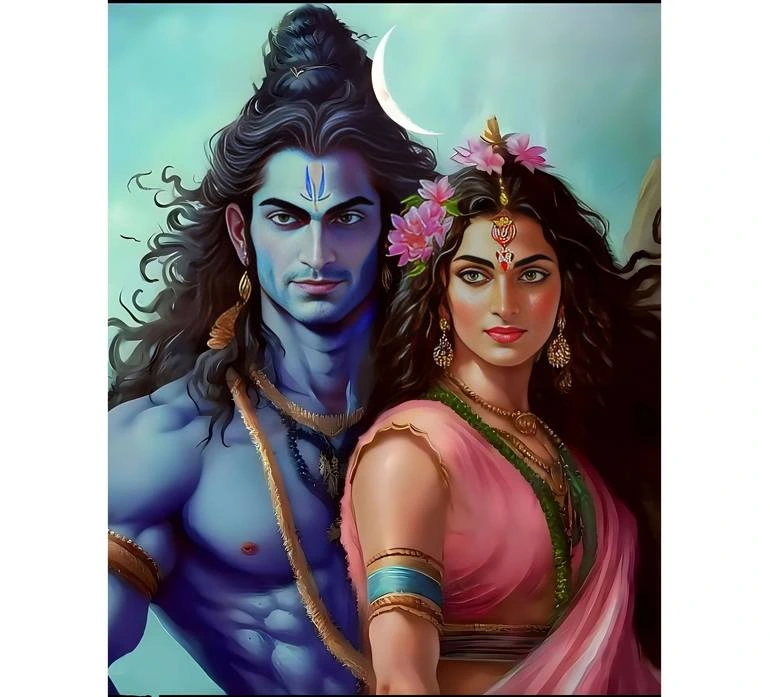
Source: Saatchi Art
Influences of other religions/cultures on Shakti
Shakti’s influence extends far beyond Hinduism’s boundaries, permeating various religious and cultural landscapes. In Buddhism, her concept is echoed in the revered female deity, Tara, who epitomizes the qualities of compassion and enlightenment. As Shakti embodies divine feminine energy, Tara serves as a guiding light for seekers on the path to enlightenment, representing compassionate wisdom (Johnson).
Shakti’s potency is embraced in the Tantric traditions, and her energies are harnessed for spiritual evolution and transformation. Shakti fosters harmony and balance by symbolizing the dynamic interplay between the divine masculine and feminine (“Shakti – New World Encyclopedia”). Tantric rituals and meditations aim to awaken the dormant energy within individuals, channeling Shakti’s power to facilitate inner growth, self-realization, and union with the divine (“Shakti”).
Modern appearances
The legacy of Shakti continues to inspire and captivate people worldwide. Even in yoga, Shakti’s divine feminine energy is revered as a vital element of spiritual practice, representing the dynamic interplay between cosmic forces and the internal energies within individuals, thereby fostering balance and enlightenment (“Shakti”). In fact, a unique yoga practice is dedicated entirely to the embodiment of Shakti. Its purpose is to awaken the divine feminine energy within oneself, promoting a greater sense of balance and harmony. By engaging in this specialized form of Yoga, one can tap into the vast reserves of power and creativity within us all.
Moreover, Shakti’s far-reaching influence is evident in the ongoing empowerment of women, recognizing their inherent strength and potential. As society increasingly acknowledges the multifaceted capacities of women, Shakti’s legacy emerges as a catalyst in transforming perceptions of femininity and power (Johnson). Her diverse manifestations, ranging from nurturing to fierce, offer a nuanced perspective on women’s various roles, fostering a culture of respect and celebration for their uniqueness and capabilities (“Shakti – New World Encyclopedia”).
In this modern era, Shakti’s legacy resonates through various dimensions of human existence, from spiritual pursuits to societal paradigms. Her influence serves as a poignant reminder of the eternal interplay between power, balance, and the divine feminine, encouraging individuals to harness their innate potential and seek harmony within themselves and the world around them.

Source: Keevs
Final thoughts
The essence of Shakti continues to radiate as a guiding light for spiritual seekers and devotees globally. Rooted in her origin story, which depicts her emergence from the very fabric of creation, the significance of Shakti is woven through her diverse incarnations, each representing a unique facet of existence. The timeless legends surrounding Shakti are poignant reminders of the universal struggle between good and evil, resonating across cultures and generations. Her narratives embody the triumph of righteousness over malevolence, a testament to the enduring power of divine forces in the cosmic narrative. As Shakti’s essence transcends time and tradition, her influence echoes in modern practices and perceptions, inspiring spiritual growth, encouraging inner transformation, and fostering a deeper connection to the sacred mysteries of existence. Her legacy as a source of strength, renewal, and spiritual awakening endures, lighting the path for those seeking to embrace the profound mysteries of the universe.
References
Johnson, Jean. “Shakti: The Power of the Feminine.” Asia Society, 2011, asiasociety.org/education/shakti-power-feminine.
“Shakti.” Wikipedia, 30 Nov. 2020, en.wikipedia.org/wiki/Shakti.
“Shakti – New World Encyclopedia.” Www.newworldencyclopedia.org, www.newworldencyclopedia.org/entry/Shakti.
Did we miss something? Do you know another aspect of this legend? Don't hesitate to reach out!
Like this project
0
A client hired me to write several informative pieces on Hindu Goddesses, and this blog post centers around the Goddess of Divine Feminine Power, Shakti.
Likes
0
Views
1328
Tags
Ghostwriter
Blog Writer


